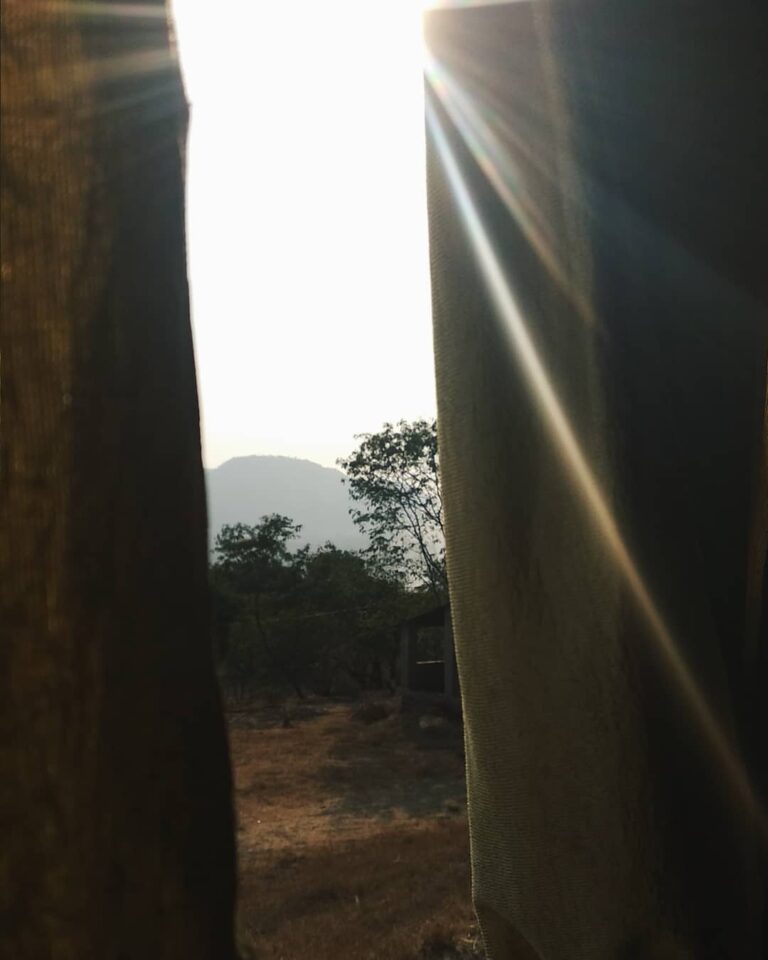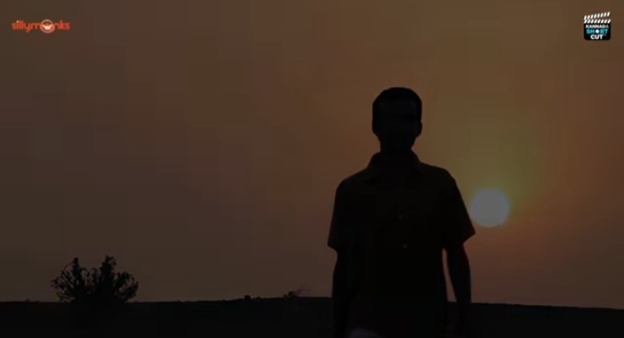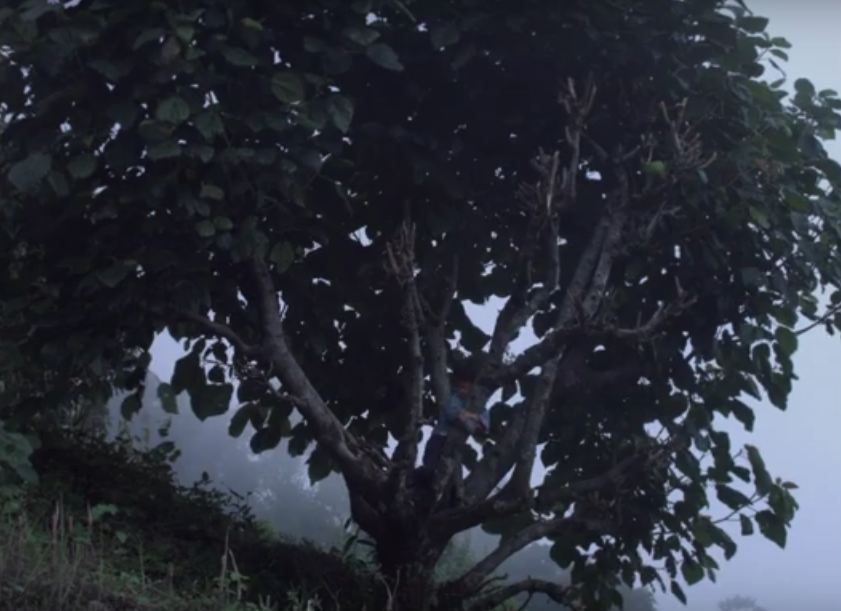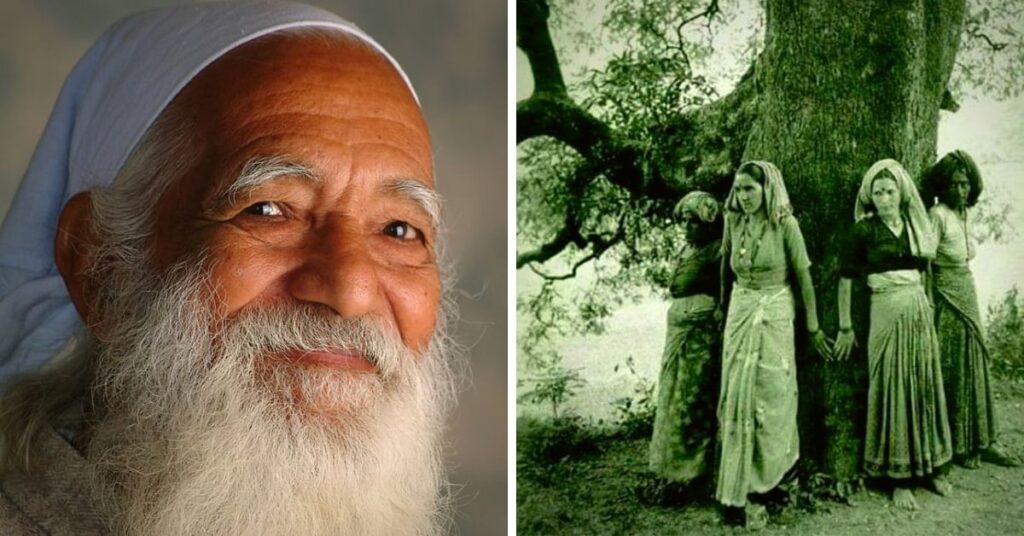This Images are Collected in Social Media from Forward Messages.
Amazing health tips
The Room in my House that I Love the Most

yellow, musky walls
cracking, just the tiniest bit
from the corners –
the ceiling fan bumping
into my head when i stand
on the bed, i am Deodar;
drums filled with clothes, cushions,
cardboard, cups, record albums,
sit next to the entrance –
their lids are my ladders,
the corner my Mario playground;
the floor, freshly layered with mud,
my bare feet,
on the palms of earth –
the brown resembles my toes,
my eyes, my hair, my skin,
this is the womb of nature;
an orange light bulb,
hanging on the left wall
is my siren,
i am hiding in this room
from the footsteps above me,
this room is my sanctuary,
my playground, my library,
my only remaining memory
of the kachcha house on the hill;
Mr. Manish S
Assistant Professor
Dept. of Psychology
Kateel Ashok Pai Memorial College, Shivamogga
The mystery that is time.

At dusk, far away on the horizon,
The sun’s brimming pot of sunshine upturned,
Shadows creeping,
Draped over me like a pashmina shawl.
The night’s stars shimmering on my skin.
My body feels like an incandescent planet.
Is this what the cosmos is made of?
Earth kneaded in Brown hues,
Voluptuous cream and leftover light.
Is this what moonshine is made of?
As I speak to the moon,
It’s crevices and layers resembling my own.
As the night whistles in the distance.
Aromas of wild rose and the taste of pure water feeds my soul.
What is this fragrance of ignorance prevailing the sky?
One more dawn,
With its brimming pot of sunshine.
Did yesterday leave already?
Holding on to my limited view,
The world must be round.
For the horizon is all I can see.
Wondering with bland amazement and despair.
How do I measure the sudden bursts of random melancholy and satisfaction?
So much of the universe,
Hidden in bundles,
Wrapped in the mystery that is time.
Mr. Manish S
Assistant Professor
Dept. of Psychology
Kateel Ashok Pai Memorial College, Shivamogga
WATER SMARTER!

“Pure water is the world’s first and Foremost medicine”
The Thunga River is a river in Karnataka state, Southern India. The river is born in the Western Ghats on a hill known as Varaha Parvata at a place called Gangmoola. From here the river flows through two districts in Karnataka that is Chikmagaluru district and Shimoga district. It is 147 km long. And merges with Bhadra River at Koodli. The river is given the compound name Tungabhadra
Water is one of the most essential resources on earth without it there would be no life on earth. Thunga river is famous for the sweetness of its water. There is a common saying in the villages “Thunga Pana Ganga Sana” which means you must bathe in Ganga and drink from Thunga.
The villagers use the Thunga river water for drinking, bathing, washing and for their cattle. Agriculture is the major occupation across the basin. The major crops grow are paddy, jowar, sugarcane, cotton, and ragi
The river catchment includes a number of large and small units supporting industrial activities. Fishing is next major activity that supports more than 10,000 families. Brick making, potter’s etc. Are other livelihood options practiced along the basin. Millions of people survive on this water source, directly or indirectly. Hence river Tungabhadra is considered to be a life line of central Karnataka.
The importance of rivers around human habitations is well known. In olden days man was content to survive and exist with the basic needs. However, as civilization progressed his needs also increased. He began to crave for more luxuries and comfort and in his greed for these he began to destroy his surroundings indiscriminately. Nowadays, water flown in rivers are not clean as it used to be. As generations passed. The pollution increased
Largely the sources of pollution in Tungabhadra river are from agricultural run off, industrial effluents, sewage from urban settlements, mining activities and over exploitation of ground water. As agriculture is the main occupation in the basins. The use of fertilizer has increased over the year. Increase in fertilizer consumption has been raised to 700 tones in 2005. A lot usage of fertilizer and pesticides are leading to eutrophication and potential contamination. Hundreds of small and large scale industries release effluents into river directly without treating it. The amounts to billion of liters of sewage and effluents polluting the river as a result turning it into a drainage and dump yard
Over the years we have been hearing about the amount of pollution caused by humans but now it is important we understand the unprecedented damage done to nature. This threatens not only us but also aquatic life.
The industrial sewage inflow has affected the nearby villages in the basin. Harihara poly fibers have affected around 45 villages. People are exposed to foul smell and several other health implications. Washer men and fishermen who spent long hours in the river had experienced skin disease and other ailments. There was a case where around 13 fishermen were suffering from skin disease ‘Superficial folliculitis ʼ an inflammation of hair follicles. Even death of cattle.
Decline in fish species is another serious issue. There were nearly 120 species of fishes in Thunga river. Among them 28 species are threatened due to over exploitation and pollution. It is also stated that fish yeild decreased by 50% over 10 years. The list of impacts caused by pollution are never ending. This is a alarming time. Thunga river is not only a boon to life it has become bane to life for villagers.
In order to restore Thunga river ecosystem we need to start taking initiative that will help Thunga river recover from the damages that has been done over the years we need to adopt systematic approaches like organic farming, sustainable fishing
It is just a beginning. A lot more needs to be done and the government has to take a serious note of saving rivers and adopt permanent solutions to prevent the chouking of the rivers by weed and pollutants. To make the process more participatory, there is also need to create awareness among people from the different walks of life.
Rivers are the cradles of civilization and it is the responsible of human being to ensure that they spring back to life.
Prerana V
I BA Student
Kateel Ashok Pai Memorial College-Shivamogga
ORGANIC FARMING

Organic farming is the best and most alternative for traditional forming tecqunicis. The producer of organic forming has high nutritional value in comparison to conventional food.
Organic farming help in reducing soil pollination and air pollination. Use of harmful chemical fertilizers and pesticides will poison our food cycle. India has the most organic farmers in the whole world
The only disadvantage of organic farming is costlier in comparison to conventional farming method. Consumption of organic food has many health benefits as compared to conventional food. The two types of organic farming are pure organic forming and integrated organic forming. The economy of scale cannot be achieved through organic farming since the production is in smaller amounts in comparison to conventional agriculture method. Health conscious consumers around the world are increasingly demanding organic foods in the market.
Feeding of increasing population of India is difficult with organic forming alone. Sudden switch over to completely organic is not possible. Moreover higher premium prices exist for organic certified products in domestic and international markets.

Organic farming is a modern and a sustainable form of agriculture that provides consumers fresh natural form products. Organic farming works in synchronisation with nature rather than against it. This objective is achieved by using techniques to improve crop yields without harming the nature environment as well as the people who live and work in it. Organic agriculture offers an exclusive amalgamation of environmental – friendly practice, which requires low external input, thereby contributing to increased food availability.
Organic forming has a very positive influence especially on Bird, insects, weeds wildlife, and soil flora and fauna. Conventional farming is capital intensive, which requires more manufactured inputs and energy as compared to knowledge and labour – intensive organic farming. Organic agriculture uses energy more competently than conventional agriculture. As compared to conventional agriculture, organic farming products cost – effective food products, free of synthetic fertilizers and pesticides. It also provides employment opportunity and economic benefits to local communities. The methods utilised in organic farming are more costly and labour intensive, but prove to be more cost effective in the long run. Since organic agriculture supplies more greenhouses gasses in the soil, the farmers across the globe can solve the climate disaster by switching to organic methods.
In Addition, organic agriculture has the potential to address food security issues. Enough evidence is available to prove that organic crops are a better of nutrients then there corresponding conventional forms. Organic system give higher animal immunity and increased diseases resistance to plants, with 50% less mycotoxins in crops and persistent shelf life.
YAMUNA.R.MYLI
1st M.Sc PSYCHOLOGY
KATEEL ASHOK PAI MEMORIAL INSTITUTE- SHIVAGOGA
Ooru (ಊರು)

Ooru (ಊರು)
Ooru, a short realistic fiction directed by Manjunath Jambe. ಊರು , village is not just a settlement of people living in community or it is just a group of houses. Villagers not only have bondage with one another but also with everything around them. So, they feel, they belongs to that place not the other way around the place belongs to them. If this sense of belonging vanishes, it leads to catastrophe. There is a tendency in village youth to abandon the village in search of luxury in cities. This is the subject of the movie Ooru.
Story: Shivram Hegde, though well educated, got a job offer in Mumbai has decided to stay in his village and received reasonable respect from villagers. He is worried about youngsters leaving villages in search of luxurious life in city. He regrets that the youngsters fail to understand that “rice can’t be born in factories and can’t get bananas out of computers”. But he has unflinching hope that his son Ravi will never abandon the village. However, Ravi gets an job offer from MNC in Bengaluru, it is a wish of every youngster to put his knowledge into practice. Ravi is no different. He compares, life in village to life of frog in a well. So he decides to leave for Bengaluru against his father’s wish.
In Bengaluru, Ravi lives a comfortable, luxurious life, he get married and later a son. He never bothers to visit his parents, once his son Adi, watching a discussion on farmer’s on TV, suddenly feels like visiting his grandparents. The labourer Rudra takes him around the village and gives a commentary on the state of affair, How their farm has given place to a factory, how people have left village in search of jobs. Adi realizes it is nothing like his father has described. He felt his father wronged his parents then Adi decides to……
What does he decide?
How does Ravi feel about his son’s decision?
Or is it just Ravi’s dream ending in Nightmare? The movie will answer.
Review: The village itself is the protagonist of the story. The characters are participants and witnesses for the changes taking place in the village. Purushottam Thalavata‘s acting gives meaning to the silence to the character Shivram hegde. The actor who played the role Rudra had given justice to the character. All other characters may have failed to be surreal.
Dialogue in this movie are like punctuations in a long sentence of silence. Even silence communicates what it can. Dialogues like “How can I sacrifice tender coconut water here, for mud water in the city” is not just Shivram hegde’s word but an explanation for the contrast between village and city. Thanks to the dialogue writer Chandan shankar.
The opening song by Ananya bhat “It has been long since we forgot our town” which expresses the regret. The Cinematography has succeeded in capturing lush green beauty of villages. Contribution of other technicians cannot be ignored.
In these days of exodus of youth from village to city, deserted village, cramped cities, soring prices, farmer’s suicide, where is to find the solace and peace? Where is the solution? The movie may have an answer.
Critics rating: 4/5
Movie link: https://youtu.be/o0QKlJzvqP0
Reviewed by:
Radhika S Joshi
2nd year BA,
Kateel Ashok Pai Memorial College, Shivamogga
ಮಗುವಾಗು ಮನವೇ………!

ಪ್ರೀತಿಯ ಓದುಗರೇ,
ಕನ್ನಡ ಚಿತ್ರರಂಗದ ಮೇರುರತ್ನಗಳಲ್ಲೊಬ್ಬರಾದ ಡಾ. ಅಶೋಕ್ ಪೈ ರವರ ಸುವರ್ಣಹಸ್ತದಿಂದ ವಿರಚಿತ ಕಥಾಸಂಕಲನಗಳಲ್ಲಿ ಒಂದಾದ ಸುರೇಶ್ ಹೆಬ್ಳೀಕರ್ ನಿರ್ದೇಶಿಸಿದ ಕನ್ನಡದ ಅದ್ಭುತ ಮನೋವೈಜ್ಞಾನಿಕ ಉಪನ್ಯಾಸ ನಾಟಕ “ಪ್ರಥಮ ಉಷಾಕಿರಣ”. ಪ್ರಸ್ತುತ ಚಲನಚಿತ್ರವು ಮಕ್ಕಳ ಮಾನಸಿಕ ಬದಲಾವಣೆಯನ್ನು ಪ್ರಥಮ ಆದ್ಯತೆಯನ್ನಾಗಿಸಿಕೊಂಡು ವೈಶಿಷ್ಟ್ಯವಾಗಿ ಚಿತ್ರೀಕರಿಸಿದ್ದಾರೆ. ಪ್ರಸ್ತುತ ಸಿನಿನಾಟಕದಲ್ಲಿ ವಿದೇಶಿ ಸಂಸ್ಕøತಿಯ ಸಂಸ್ಕಾರಗಳಿಂದ ಬದಲಾದ ಒಬ್ಬ ತಂದೆಯ ಶಿಸ್ತು ಮತ್ತು ಅನೌಪಚಾರಿಕ ನಡತೆಗಳಿಂದ ಕಂಗೆಟ್ಟ ಆತನ ಇಬ್ಬರು ಮಕ್ಕಳ ಮೇಲಾದ ಮಾನಸಿಕ ದುರಾವಸ್ಥೆ ಶೋಷಣೆಯ ಪರಿಣಾಮವನ್ನು ಚಿತ್ರದ ಕೈಗನ್ನಡಿಯನ್ನಾಗಿ ರೂಪಿಸಿದ್ದಾರೆ.
ಆಧುನಿಕ ತಂತ್ರಜ್ಞಾನದಲ್ಲಿ ಮಕ್ಕಳಗತಿ ಅಧೋಗತಿ! ಏಕೆಂದರೆ ಸ್ವಲ್ಪವೂ ಹೊರಕೌಶಲ್ಯಗಳಲ್ಲಿ ತೊಡಗಿಕೊಳ್ಳದೆ ಶೈಕ್ಷಣಿಕ ಒತ್ತಡಕ್ಕೆ ಮಣಿದು ಬೆಟ್ಟವನ್ನು ತಲೆಯ ಮೇಲೆ ಹೊತ್ತಂತೆ ಕಾಣುವುದು ಅವರ ಮುಖ! ನಗರಗಳಲ್ಲಿ ಚಿಕ್ಕ ಮಗುವಿಗೆ ಕುಡಿಯುವ ಹಾಲು ಎಲ್ಲಿಂದ ಬರುತ್ತದೆ ಎಂದು ಕೇಳಿದಾಗ ಆ ಮುಗ್ಧ ಮಗು ಗಾಡಿಯಲ್ಲಿ ಬರುತ್ತದೆ ಎಂದು ಹೇಳಿದಾಗ ಉಂಟಾಗುವ ನಗು ಹಾಗೂ ಆಶ್ಚರ್ಯವೇ ಹೇಳುತ್ತದೆ ಆಧುನಿಕ ತಂತ್ರಜ್ಞಾನ ಎಲ್ಲವನ್ನೂ ಬದಲಿಸಿದೆ ಎಂದು. “ಏನ್ ಕಾಲ ಬಂತಪ್ಪಾ, ನಮ್ ಕಾಲದಲ್ಲಿ ಹೀಗೆಲ್ಲಾ ಇರ್ಲಿಲ್ಲಾ!” ಎಂದು ನುಡಿಯುವ ಹಿರಿಯರ ಆಶ್ಚರ್ಯದ ಮಾತು ನಿಜ ಅನ್ಸುತ್ತೇ. ಚಲನಚಿತ್ರದ ವಿಷಯಕ್ಕೆ ಬಂದರೆ ಪ್ರಸ್ತುತ ಚಲನಚಿತ್ರವು 1990 ಇಸವಿಯಲ್ಲಿ, ಸುರೇಶ್ ಹೆಬ್ಳೀಕರ್ ಮುಖ್ಯಭೂಮಿಕೆಯಲ್ಲಿ, ಡಾ. ಅಶೋಕ್ ಪೈ ವಿರಚಿತ ಮತ್ತು ನಿರ್ಮಾಪಕರಾಗಿ ಕಾರ್ಯ ನಿರ್ವಹಿಸಿದ ಅದ್ಭುತ ಚಲನಚಿತ್ರ “ಪ್ರಥಮ ಉಷಾಕಿರಣ”.
ಮುಖ್ಯ ಪಾತ್ರಗಳು:
ಸುರೇಶ್ ಹೆಬ್ಳೀಕರ್ – ಶ್ರೀಧರ್ ಆಗಿ ನಟಿಸಿದ್ದಾರೆ.
ಗೀತಾ _ ಶ್ರೀಧರನ ಪತ್ನಿಯಾಗಿ ನಟಿಸಿದ್ದಾರೆ.
ಗಿರೀಶ್ ಕಾರ್ನಾಡ್ _ ಮನೋವೈದ್ಯರಾಗಿ ನಟಿಸಿದ್ದಾರೆ.
ಉಷಾ ಮತ್ತು ಕಿರಣ್ ಶ್ರೀಧರನ ಇಬ್ಬರು ಮಕ್ಕಳಾಗಿ ತಮ್ಮ ನಟನಾ ಮುಖ್ಯಭೂಮಿಕೆಯಲ್ಲಿ ಪ್ರಮುಖ ಪಾತ್ರವಹಿಸಿದ್ದಾರೆ.
ಪ್ರಸ್ತುತ ಚಲನಚಿತ್ರದಲ್ಲಿ ಶ್ರೀಧರ್ ಒಬ್ಬ ಪ್ರಾಮಾಣಿಕ, ಬುದ್ಧಿವಂತ, ಮಧ್ಯಮವರ್ಗದ ಕುಟುಂಬಕ್ಕೆ ಸೇರಿದ ಸಾಮಾನ್ಯ ಯುವಕ. ಮೂರು ವರ್ಷ ಹೊಸ ಕೆಲಸದ ಹುಮ್ಮಸ್ಸಿನೊಂದಿಗೆ ಅಮೇರಿಕಾಗೆ ತನ್ನ ಮಡದಿಯೊಂದಿಗೆ ತೆರಳಿದ ಆತ ಅಮೇರಿಕಾದ ನಡವಳಿಕೆ ಮತ್ತು ಸಂಸ್ಕøತಿಗೆ ಮರುಳಾಗುತ್ತಾನೆ. ಭಾರತಕ್ಕೆ ಮರಳಿದ ನಂತರ ತನ್ನ ನಡವಳಿಕೆ ಹಾಗೂ ಶಿಸ್ತನ್ನು ತನ್ನ ಎಳೆಯ ಮಕ್ಕಳ ಮೇಲೆ ಭಾರವನ್ನು ಹೇರುತ್ತಾನೆ. ಇದರಿಂದ ವಿಚಲಿತಗೊಂಡ ಇಬ್ಬರು ಮಕ್ಕಳು ಮಾನಸಿಕವಾಗಿ ಅಸ್ವಸ್ಥರಾಗುತ್ತಾರೆ. ಅದರ ಪರಿಣಾಮವಾಗಿ ವಿಚಿತ್ರವಾದ ನಡವಳಿಕೆಗಳನ್ನು ಪ್ರದರ್ಶಿಸತೊಡಗುತ್ತಾರೆ.
ವಿದೇಶಿ ಸಂಸ್ಕøತಿಗೆ ಬದಲಾದ ವ್ಯಕ್ತಿತ್ವ ಮತ್ತು ವರ್ತನೆಗಳು, ಶಾಲಾ ಪರಿಸ್ಥಿತಿ ಹಾಗೂ ಹಳ್ಳಿ ಶಾಲೆಯ ದುಸ್ಥಿತಿ, ಮಕ್ಕಳಲ್ಲಾಗುವ ಮಾನಸಿಕ ಬದಲಾವಣೆ ಹಾಗೂ ಪರಿಣಾಮಗಳು ಚಲನಚಿತ್ರದಲ್ಲಿ ಕಾಣಬಹುದಾದ ಪ್ರಮುಖ ಅಂಶಗಳಾಗಿವೆ. ಅಂತಿಮವಾಗಿ ಮಕ್ಕಳ ಮನೋವ್ಯಾಧಿಯನ್ನು ಅರ್ಥಮಾಡಿಕೊಂಡ ಪರಿಣಿತ ಮನೋಶಾಸ್ತ್ರಜ್ಞ (ಗಿರೀಶ್ ಕಾರ್ನಾಡ್) ರೊಬ್ಬರು ಅವರಿಬ್ಬರ ದುರವಸ್ಥೆಯ ಕಾರಣವನ್ನು ತಂದೆಗೆ ವಿವರವಾಗಿ ಅರ್ಥಮಾಡಿಸುತ್ತಾರೆ. ಹೀಗೆ ಉತ್ತಮ ಸಂದೇಶದೊಂದಿಗೆ ಮುಕ್ತಾಯವಾದ ನಾನು ಕಂಡಂತಹ ಅದ್ಭುತ ಚಿತ್ರ ಪ್ರಥಮ ಉಷಾಕಿರಣ ‘ಪೋಷಕರ ಹೃದಯ ಮಕ್ಕಳು’ ಎಂದು ಎಲ್ಲರಿಗೂ ತಿಳಿದಿರುವ ವಿಷಯ. ಕಹ್ಲಿಲ್-ಗಿಬ್ರನ್ ರವರ ಪ್ರಕಾರ ಮಕ್ಕಳು ಬಾಣ(ಶರ) ದಂತೆ ಹಾಗೂ ಪೋಷಕರು ಬಾಣವನ್ನು ಗುರಿಯೆಡೆಗೆ ತಲುಪಿಸುವ ಬಿಲ್ಲಿನಂತೆ ಇರಬೇಕು. ಏಕೆಂದರೆ ಬಿಲ್ಲು ಸದೃಢವಾಗಿ ತನ್ನನ್ನು ತಗ್ಗಿಸಿಕೊಂಡಷ್ಟು ಬಾಣವು ಕಠಿಣದೂರವನ್ನು ತಲುಪಿ ಗುರಿಯ ಕೇಂದ್ರವನ್ನು ಮುಟ್ಟುತ್ತದೆ.
ಪ್ರಸ್ತುತ ಚಲನಚಿತ್ರದಲ್ಲಿ ನಾನು ಹೆಚ್ಚಾಗಿ ಗಮನವಿಟ್ಟು ವೀಕ್ಷಿಸಿದ ಮನೋಹರ ದೃಶ್ಯವೆಂದರೆ ಹಿರಿಯರು ಮೊಮ್ಮಕ್ಕಳಿಗೆ ಹೇಳುವ ಧಾರ್ಮಿಕ ನೀತಿಯುಕ್ತ ಕಥೆ. ನಾನು ಈ ವಿಷಯವನ್ನು ಹೆಚ್ಚಾಗಿ ವಿಮರ್ಶಿಸಿದೆ ಏಕೆಂದರೆ ಇಂದಿನ ದಿನಗಳಲ್ಲಿ. ಆ ಸಂತೋಷದ ಕ್ಷಣಗಳು ತಂತ್ರಜ್ಞಾನದ ತುಳಿತಕ್ಕೆ ಸಿಕ್ಕಿ ಸತ್ತುಹೋಗಿವೆ. ನನ್ನ ಅನುಭವದಿಂದ ಹೇಳಬೇಕಾದರೆ ನನ್ನ ಅಜ್ಜ ಕೂಡ ನಾನು ಚಿಕ್ಕವನಿದ್ದಾಗ ಅನೇಕ ಧಾರ್ಮಿಕ, ವೈಚಾರಿಕ ಕಥೆಯಿಂದ ನನ್ನ ಕುತೂಹಲವನ್ನು ಕೆರಳಿಸಿ ತಣಿಸುತ್ತಿದ್ದರು. ಆದರೆ ಈಗ ಕಥೆಯೂ ಇಲ್ಲ, ಅಜ್ಜನೂ ಇಲ್ಲ! Only voot kids. ಈ ಚಲನಚಿತ್ರವು ನನ್ನನ್ನು ಇಂದಿನ ಪೋಷಕರ ವರ್ತನೆಯ ಕುರಿತು ವಿಚಾರ ಮಾಡುವಂತೆ ಮಾಡಿತು. ಅದನ್ನು ನಿಮ್ಮೊಂದಿಗೆ ಹಂಚಿಕೊಳ್ಳುತ್ತಿದ್ದೇನೆ.
ಇಂದಿನ ದಿನಗಳು ನಿಜವಾಗಲೂ ಅಂದಿನಂತಿಲ್ಲ. ನಿಮ್ಮ ಅನುಮತಿಯಿದ್ದರೆ ನನ್ನದೊಂದು ಪುಟ್ಟ ಕಥೆ, ವಿದ್ಯಾಭ್ಯಾಸದ ನಂತರ ಹೊರದೇಶಕ್ಕೆ ಕೆಲಸಕ್ಕೆಂದು ಹೋದ ಒಬ್ಬ ಮಗನಿದ್ದ. ಒಮ್ಮೆ ಆತನ ತಂದೆ, ಮಗನಿಗೆ ತನ್ನ ಮರಣಕಾಲ ಸಮೀಪಿಸಿದೆ ಎಂದು ತಾನು ನಿನ್ನೊಮ್ಮೆ ನೋಡಬೇಕೆಂದು ಅಭಿಲಾಷೆಯನ್ನು ವ್ಯಕ್ತಪಡಿಸಿದಾಗ ಆ ಹುಡುಗನು ಹೇಳಿದನು. “Sorry dad, I am busy with my work”. . ಕೊನೆಗೆ ತಂದೆಯ ಮರಣನಂತರ ಸ್ನೇಹಿತರ ಕರೆಯನ್ನು ಸ್ವೀಕರಿಸಿ ಹೇಳಿದನು. “Sorry dude, please complete my all duties regarding my father”. ವಿಪರ್ಯಾಸವೆಂದರೆ ತನ್ನ ತಂದೆಯ ಮುಖವನ್ನು ಸಹ ನೋಡಲಿಕ್ಕಾಗದ ಆತ ತನ್ನ ಫೇಸ್ಬುಕ್ ಪೋಸ್ಟ್ನಲ್ಲಿ ಬರೆದುಕೊಂಡನು ಹೀಗೆ. “RIP, miss u dad..!”
ಆಧುನಿಕ ದಿನಗಳಲ್ಲಿ ಜನರ ಕಣ್ಣುಗಳು ಅವರವರ ಕನ್ನಡಕಗಳಿಂದ ವರ್ಣಮಯವಾಗಿ ಪ್ರಜ್ವಲಿಸುತ್ತಿವೆ. ಏಕೆಂದರೆ ಹೊರಗಿನ ಜಗತ್ತು, ಅವರ ಕನ್ನಡಕಗಳಿಂದ ಬದಲಾಗುತ್ತಿರುವ ಅವರ ವೀಕ್ಷಣೆ, ಎಲ್ಲವೂ ವಿಭಿನ್ನ.
ನಾನು ಗಮನಿಸಿರುವ ಒಂದು ವಿಷಯವೇನೆಂದರೆ ಪೋಷಕರು ಪರೀಕ್ಷಾ ಸಮಯದಲ್ಲಿ ಮಕ್ಕಳಿಗೆ ಸ್ಫೂರ್ತಿ ತುಂಬುತ್ತಾರೆ. ಹೇಗೆಂದರೆ, “ಮಗೂ ನಿನ್ನಿಂದ ಸಾಧ್ಯ” (you can do it) ಇದು ತಪ್ಪು ನಡವಳಿಕೆ. ಏಕೆಂದರೆ ಈ ಒಂದು ಮಾತು ಅನೇಕ ಆತ್ಮಹತ್ಯೆಗಳಿಗೆ ಕಾರಣವಾಗಿದೆ. ಈಗಷ್ಟೇ ಆಗ ಜನಿಸಿದ ಮಗುವಿನ ಕಿವಿಯಲ್ಲಿ ಅಪ್ಪ, ಅಮ್ಮ ಎಂದು ಹೇಳುವ ಬದಲು Doctor, Engineer ಎಂದು ಹೇಳುವ ದಾರಿದ್ರ್ಯ ಬಂದೊದಗಿದೆ. ಪೋಷಕರ ಒತ್ತಡದ ವರ್ತನೆ, ಸಂಬಂಧಿಕರ ಅನಗತ್ಯ ಸಂಭಾಷಣೆ, ಹೊರಗಿನ ತಂತ್ರಜ್ಞಾನ ಎಲ್ಲವೂ ಮಕ್ಕಳ ಮನಸ್ಸಿನ ಮೇಲೆ ಪರಿಣಾಮ ಬೀರಿದೆ ಎನ್ನುವುದರಲ್ಲಿ ಎರಡು ಮಾತಿಲ್ಲ.
ಒಂದು ನಿದರ್ಶನ ಎಂದರೆ ಇಬ್ಬರು ಅಕ್ಕಪಕ್ಕದ ಮನೆಯ ಹೆಂಗಳೆಯರು ತನ್ನ ಇಬ್ಬರು ಮಕ್ಕಳೊಂದಿಗೆ ಶಾಲಾ ವಾಹನಕ್ಕಾಗಿ ಕಾದಿದ್ದರು. ಆಗ ಆಕಸ್ಮಿಕವಾಗಿ ಒಬ್ಬ ಭಿಕ್ಷುಕನು ಭಿಕ್ಷೆಗಾಗಿ ಹಣವನ್ನು ಬೇಡಿ ಹೊರಟ. ಆಗ ಒಬ್ಬ ತಾಯಿಯು ತನ್ನ ಮಗುವಿಗೆ, “ಮಗೂ ನೀನು ವಿದ್ಯಾಭ್ಯಾಸ ಚೆನ್ನಾಗಿ ಮಾಡದಿದ್ದರೆ ಈ ರೀತಿ ಆಗುತ್ತೀಯಾ ಎಂದು ಹೇಳಿದಳು. ಇದನ್ನು ಕೇಳಿದ ಮತ್ತೊಬ್ಬ ತಾಯಿಯು ತನ್ನ ಮಗುವಿಗೆ, “ಪುಟ್ಟಾ, ನೀನು ವಿದ್ಯಾಭ್ಯಾಸ ಚೆನ್ನಾಗಿ ಮಾಡಿದರೆ ಇಂತಹ ಅನೇಕ ಭಿಕ್ಷುಕರಿಗೆ ಆಸರೆಯಾಗಬಹುದು.” ಈ ರೀತಿಯ ಬದಲಾವಣೆ ನಿಜವಾಗಲೂ ಬೇಕಾಗಿದೆ. ಆದರೆ ಇಂತಹ ಆಲೋಚನೆಯುಳ್ಳ ತಾಯಂದಿರು ವಿರಳ.
ಪೋಷಕರು ತಮ್ಮ ಐಷಾರಾಮಿ ಜೀವನದ ತುಣುಕನ್ನು ತಮ್ಮ ಮಕ್ಕಳಿಗೆ ಕೊಡುತ್ತಾರೆ. ಆದರೆ ಈ ಮಕ್ಕಳನ್ನು ನೋಡಿದ ಇನ್ನೊಂದು ಮಗು ತಾನೂ ಅವರಂತೆಯೇ ಐಷಾರಾಮವಾಗಿ ಬದುಕಬೇಕೆಂದು ದುಡ್ಡಿನ ಹಿಂದೆ ಓಡಲು ಶುರುಮಾಡುತ್ತಾನೆ. “ಇಂದಿನ ಮಕ್ಕಳೇ ಮುಂದಿನ ಪ್ರಜೆಗಳು” ಎಂಬ ಮಾತು ಸುಳ್ಳೋ, ನಿಜವೋ ಗೊತ್ತಿಲ್ಲ. ಆದರೆ ಪ್ರತಿ ಮಗುವೂ ತನ್ನ ಸ್ವಂತ ಸುಖದೆಡೆಗೆ ಓಡುತ್ತಿರುವುದಂತೂ ನಿಜ.
ಪೋಷಕರ ಹಾಗೂ ಮಕ್ಕಳ ಸಂಬಂಧ ಸೂರ್ಯ ಹಾಗೂ ಚಂದ್ರನಂತಿರಬೇಕು. ಏಕೆಂದರೆ ಸೂರ್ಯ ಮತ್ತು ಚಂದ್ರರ ನಡುವಿನ ಪ್ರೀತಿಯ ಕಾಂತಿ ಹಾಗೂ ಮಮತೆ ಯಾರಿಗೂ ಕಾಣುವುದಿಲ್ಲ. ಆದರೆ ಸೂರ್ಯನ ಕಿರಣ ಚಂದ್ರನನ್ನು ಸ್ಪರ್ಶಿಸುತ್ತಲೇ ಚಂದ್ರನು ಪ್ರಕಾಶಿಸಲು ಶುರುಮಾಡುತ್ತಾನೆ. ಹೀಗೆಯೇ ಪೋಷಕರ ವಿಚಾರ ನಡವಳಿಕೆಗಳು ಸೂರ್ಯನ ಕಿರಣದಂತಿರಬೇಕು. ಆಗ ಮಾತ್ರ ಸಾಧನೆ ಎಂಬ ಭೂಮಿಗೆ ಚಂದ್ರನ ಪ್ರಭೆ ಸಾಧ್ಯ.
ಬದಲಾಗಬೇಕಾಗಿರುವುದು ಅವರು ಇವರಲ್ಲ ನಾನು ಎಂದುಕೊಂಡು ತಮ್ಮ ಆಸೆ ಬಯಕೆಗಳನ್ನು ಮಕ್ಕಳ ಮೇಲೆ ತೋರ್ಪಡಿಸಿಕೊಳ್ಳದೇ ಸ್ವತಂತ್ರವಾಗಿ ಮಕ್ಕಳನ್ನು ಪಕ್ಷಿಯಂತೆ ಹಾರಲು ಬಿಡಿ ಅನ್ನುವುದೇ ನನ್ನ ಅಭಿಪ್ರಾಯ.
Today’s children are the brightest future of a country.
ಮಗುವಾಗು ಮನವೇ………!
ರಕ್ಷಿತ್ ಎಚ್. ಆರ್
ಪ್ರಥಮ ಬಿ. ಎ , ವಿದ್ಯಾರ್ಥಿ
ಕಟೀಲ್ ಅಶೋಕ್ ಪೈ ಸ್ಮಾರಕ ಕಾಲೇಜ್, ಶಿವಮೊಗ್ಗ
The Vocabulary in which I Love

The vocabulary in which i love
if the language I speak could dissect
itself into fragments that could splatter
across the street and write you a poem,
A would say that the ability to love is
drawn from the countless scars of
yesterday’s heartbreak.
B would walk in to the room and become
the white lily that you placed on
my table because you
thought flowers ignite hope.
C would call you the light of my life.
D would dance at the sight of your
eyes, brown, in the face of the sunlight.
E would whisper everything that i am
too afraid to say.
F would forget to breathe at the
unintentional brush of the back of my
hand against yours.
G would gladly correct me when i say
it was nothing but an accident when
your skin touched mine.
H would ask me to hold your hand,
intentionally this time.
I would still be unable to utter a single
word in your presence.
J would play ‘Just kiss her by Concorde’
when you and I sit tipsy in a room.
K would kill its darlings and find
better ways to write a love poem.
L wouldn’t think twice before falling in
love with you all over again.
M would tell you that there is no love
in maybe.
N would call your name a thousand
times like a prayer.
Oh, this poem is getting out of my
hands.
P would say “its’s a love story…”
please say yes?
Q wouldn’t question the signs of the
Universe.
R would rivet in the gentleness of
admiration.
Shame on me for not being able to
Tell you that this poem is for you
instead,
V would rather stand in the corner
Without making a single sound and
Xpect you to understand
Why
the alphabets end at Z but
my love does not.
Mr. Manish S
Lecturer, Dept. of Psychology
Kateel Ashok Pai Memorial College – Shivamogga
ಮಂಜಿನಲ್ಲಿ ಬರಿಯ ಮರಗಳು

ಮಂಜಿನಲ್ಲಿ ಬರಿಯ ಮರಗಳು (Bare Trees In The Mist- Nepal)
ಹಲವು ಉದ್ದೇಶ, ಗುರಿ, ಸಂತೋಷ, ನೆಮ್ಮದಿಗಳನ್ನು ಬಯಸುವ ವ್ಯಕ್ತಿ ಅದೇ ಗುರಿಯ ಕಡೆಗೆ ಸಾಗಲು ಹೊರಡುತ್ತಾನೆ. ಆದರೆ ಅದಕ್ಕೆ ಒಂದು ನಿರ್ದಿಷ್ಟ ಗುರಿ ಇರುತ್ತದೆ, ಆದರೆ ತನ್ನ ಗಂಡನ ಬರುವಿಕೆಯನ್ನೇ ಮುಖ್ಯಗುರಿ ಎಂದೆನಿಸಿಕೊಂಡ ಕಾಲಿ ಎಂಬ ಮಹಿಳೆಯ ಕುರಿತು ಚಿತ್ರಿಸಿರುವ ಕಿರುಚಿತ್ರವೇ ‘ಮಂಜಿನಲ್ಲಿ ಬರಿಯ ಮರಗಳು’ಎಂಬ ನೇಪಾಳಿ ಭಾಷೆಯ ಕಿರುಚಿತ್ರ.
ಪ್ರಜ್ವಲ್ ನಿರ್ಮಾಣದ ರಾಜನ್ ಕಾರ್ತೂನ್ ನಿರ್ದೇಶಿಸಿ ರಚಿಸಿರುವ ಕಿರುಚಿತ್ರ, ಒಬ್ಬ ಮಹಿಳೆಯ ಜವಾಬ್ದಾರಿಯಾದ ತಾಯಿ, ಹೆಂಡತಿ, ನೆರೆಹೊರೆಯ ಪಾತ್ರ ಕೆಲಸ ಇತ್ಯಾದಿಗಳ ಜೊತೆಜೊತೆಗೆ ತನ್ನ ಸಂವೇದನಶೀಲವಾದ ಪ್ರೀತಿ ಪ್ರೇಮ ನೋವು ಹತಾಶೆ ಇವುಗಳನ್ನು ಬಿಚ್ಚಿಡುತ್ತಾ ಸಾಗುತ್ತದೆ. ಮೊದಲಾರ್ಧ ಭಾಗದಲ್ಲಿ ನೇಪಾಳದ ಹಿಮಾವೃತ ಚಿತ್ರಣವನ್ನು ಚಿತ್ರಿಸಿ ಜೀವನದ ಭಾರಹೊತ್ತ ತಾಯಿಯ ಜೊತೆಗೆ – ಮಗನ ಬೇಡಿಕೆಯನ್ನು ಪೂರೈಸಲು ಸಾಧ್ಯವಾಗದ ಸ್ಥಿತಿಯಲ್ಲಿ ನಾವು ಕಾಲಿ ಎಂಬ ಮಹಿಳೆಯ ಪಾತ್ರವನ್ನು ನೋಡಬಹುದಾಗಿದೆ.
ಕಿರುಚಿತ್ರ, ಎರಡು ಸಂಸಾರದ ಚಿತ್ರಣವನ್ನು ಚಿತ್ರಿಸುತ್ತದೆ, ಒಂದು ಸಂಪದ್ಭರಿತ ಕೂಡುಕುಟುಂಬ ಅಂದರೆ ಚಾರ್ಲಿ, ಚಾರ್ಲಿಯ ತಂದೆ ಮತ್ತು ಚಾರ್ಲಿಯ ತಾಯಿ- ಮತ್ತೊಂದು ಕಾಲಿ ಮತ್ತು ಅವಳ ಮಗ, ಆದರೆ ಕಾಲಿಯ ಗಂಡ ವಿದೇಶದಲ್ಲಿ ಕೆಲಸಕ್ಕೆಂದು ದುಡಿಯಲು ಹೋಗಿದ್ದಾನೆ ಆದರೆ ವಿಪರ್ಯಾಸ ಎಂದರೆ ಕಾಲಿಯ ಮುಗ್ದತನ ಅರ್ಥವಾಗುವುದು ಚಾರ್ಲಿಯ ತಂದೆ ‘ನಿನ್ನ ಗಂಡ ಯಾವ ದೇಶಕ್ಕೆ ಹೋಗಿದ್ದಾನೆ ಎಂದು ಕೇಳಿದಾಗ ಅದಕ್ಕೆ ಉತ್ತರ “ಅರಬ್ ದೇಶ” ಎಂದು ಮಾತ್ರವಾಗಿತ್ತು. ಆದರೆ ಅರಬ್ ದೇಶದ ಯಾವ ಭಾಗದಲ್ಲಿ ಎಂದು ಕೇಳಿದಾಗ ಅವಳಲ್ಲಿ ಉತ್ತರ ಇರಲಿಲ್ಲ’. ಇಲ್ಲಿ ನಿರ್ದೇಶಕ ಕಾಲಿಯ ಜವಾಬ್ದಾರಿಯನ್ನು ಹೊಲ ಊಳಲು ಬಳಸುವ ನೊಗದಂತೆ ಚಿತ್ರಿಸಿದ್ದಾರೆ,ಅರ್ಥತ್ ‘ನೊಗ ಹೊತ್ತ ಮಹಿಳೆಯ ಮೂಕ ನಡಿಗೆಯು ವೀಕ್ಷಕರಿಗೆ ಸಾವಿರ ಭಾವನೆಯನ್ನು ಕಾಲಿಯ ನೋವು, ಹತಾಶೆ, ದಿಕ್ಕೇತೋಚದ ಸ್ಥಿತಿ – ಎಂತಹದ್ದು ಎಂದು ಅರಿವಾಗುತ್ತದೆ,
ಈ ಕಿರುಚಿತ್ರದಲ್ಲಿ ಸುಖೀ ಕುಟುಂಬ ಅಂದರೆ ಚಾರ್ಲಿಯ ಕುಟುಂಬ ಸುಖ ಸಂತೋಷದಿಂದ ಕೂಡಿದ್ದು ಕಾಲಿಯ ಸ್ಥಿತಿಗೆ ಅವಮಾನಿಸುವ ವ್ಯಕ್ತಿತ್ವ ಎಂಬಂತೆ ಭಾಸವಾಗುತ್ತದೆ. ಕೊನೆಯ ದೃಶ್ಯದಲ್ಲಿ ಚಾರ್ಲಿ ತನ್ನ ಕಾಲನ್ನು ಗೋಡೆಗೆ ಹೊಡೆಯುವ ದೃಶ್ಯದ ಶಬ್ದ, ಚಾರ್ಲಿ ತಾಯಿ ರುಬ್ಬುತ್ತಿರುವ ಶಬ್ದ, ಮತ್ತು ಚಾರ್ಲಿಯ ತಂದೆ ಕಟ್ಟಿಗೆಯನ್ನು ಇಬ್ಭಾಗ ಮಾಡುವಾಗ ಮೂಡಿದ ಶಬ್ದವನ್ನೇ – ‘ಕಾಲಿಯಾ ಎದೆಬಡಿತವನ್ನು ‘ಮತ್ತು ವೀಕ್ಷಕರಿಗೆ ಮುಂದೇನಾಗುತ್ತದೋ ಎಂಬ ಆಲೋಚನೆಯನ್ನು ಮೂಡಿಸುತ್ತಾರೆ ಧ್ವನಿ ಸಂಯೋಜಕರಾದ ಡಿಕೇಶ್ ಕಾಡ್ಗಿ ಶಾಹಿ ಮತ್ತು ಸಾರ ತಮಾಗ್ ರವರು.
ಚಿತ್ರದ ಛಾಯಾಗ್ರಹಣದ ವಿಷಯಕ್ಕೆ ಬಂದರೆ ಮಂಜು ಮುಸುಕಿನ ಪ್ರದೇಶದಲ್ಲಿ ಚಿತ್ರಿಸಿದ್ದಾರೆ, ಒಟ್ಟಾರೆ ಇಡೀ ಚಿತ್ರದಲ್ಲಿ ತಿಳಿ ಕಪ್ಪು ಬಣ್ಣದಲ್ಲಿ ಮೂಡಿ ಬಂದಿದ್ದು ವೀಕ್ಷಕರಿಗೆ ಮನಮುಟ್ಟುವಂತೆ ಸೆರೆಹಿಡಿದಿದ್ದಾರೆ ಛಾಯಾಗ್ರಾಹಕ. ಚಿತ್ರದ ಸಕಾರಾತ್ಮಕ ಅಂಶವೆಂದರೆ ಅಷ್ಟು ಪಾತ್ರದಾರಿಗಳ ಸ್ವಾಭಾವಿಕ ನಟನೆ, ಹಿನ್ನೆಲೆ ಧ್ವನಿಯಾದ ಹಕ್ಕಿಗಳ ಚಿಲಿಪಿಲಿ ಕಲರವ ಮತ್ತು ಸಾಕು ಪ್ರಾಣಿಗಳ ಶಬ್ದ,ಛಾಯಾಗ್ರಹಣ ಮತ್ತು ಹಿನ್ನೆಲೆ ಸಂಗೀತ ಚಿತ್ರದ ಸಕಾರಾತ್ಮಕ ಅಂಶಗಳಲ್ಲೊಂದು, ಇನ್ನು ಚಿತ್ರದ ‘ಚಿಹ್ನೆ’ ವಿಷಯಕ್ಕೆ ಬಂದರೆ ಮೂಕನಡಿಗೆ,ಕಟ್ಟಿಗೆ, ಇವೆಲ್ಲವೂ ನೂರಾರು ಭಾವನೆಗಳನ್ನು ಮತ್ತು ನೇಪಾಳದ ಭಾಗದ ಜನರ ಸಂಸ್ಕೃತಿಯನ್ನು ಪ್ರತಿಬಿಂಬಿಸುತ್ತದೆ.
ಪಾತ್ರಧಾರಿಗಳ ಮೆಲ್ಲು ಧ್ವನಿ -ವೀಕ್ಷಕರಿಗೆ ಅಸಮಾಧಾನ ಮೂಡಿಸುತ್ತದೆ, ಕೆಲವೊಂದು ಸಂಭಾಷಣೆ ಮತ್ತು ಸೆರೆಹಿಡಿದಿರುವ ದೃಶ್ಯ ಮೂಕ ನಡಿಗೆ ವೀಕ್ಷಕರಿಗೆ ತುಸು ಹೆಚ್ಚಾಯಿತು ಎಂದು ಭಾಸವಾಗುತ್ತದೆ. ‘ಮಂಜಿನಲ್ಲಿ ಬರಿಯ ಗಿಡಗಳು’ ( Bare Trees In The Mist ) ಎಂಬ ಶೀರ್ಷಿಕೆ ನೇಪಾಳದ ಪ್ರಕೃತಿಸೌಂದರ್ಯದ ಜೊತೆಜೊತೆಗೆ ಕಾಲಿಯ ಸ್ಥಿತಿಯನ್ನು ಹೋಲುತ್ತದೆ.
ಒಟ್ಟಾರೆಯಾಗಿ ಈ ಚಿತ್ರವನ್ನು ವಿವಿಧ ಸಂಸ್ಕೃತಿ ಭಾಷೆ ಮತ್ತು ಪ್ರಕೃತಿಯನ್ನು ಅರಿಯುವ ಸಲುವಾಗಿ, ವ್ಯಕ್ತಿಗತ ಸಂಬಂಧ- ಪ್ರೀತಿಯ ಮಹಿಮೆ ಮತ್ತು ತನ್ನವರಿಂದ ದೂರವಾದ ವ್ಯಕ್ತಿಯ ನೋವು ಎಂತಹದ್ದು ಎಂದು ಅರಿಯುವ ಸಲುವಾಗಿ ಈ ಚಿತ್ರವನ್ನು ನೋಡಬಹುದಾಗಿದೆ.
ಒಟ್ಟಾರೆಯಾಗಿ ಈ ಚಿತ್ರಕ್ಕೆ ಐದು ಅಂಕದಲ್ಲಿ ವಿಮರ್ಶಿಸುವುದಾದರೆ 4:50 ಅಂಕವನ್ನು ಯಾವುದೇ ಪೂರ್ವಾಗ್ರಹವಿಲ್ಲದೆ ನೀಡಬಹುದು.
ಉಮರ್ ಫಾರೂಕ್
ತೃತೀಯ ಬಿ. ಎ
ಕಟೀಲ್ ಅಶೋಕ್ ಪೈ ಸ್ಮಾರಕ ಕಾಲೇಜ್, ಶಿವಮೊಗ್ಗ
ಪರಿಸರವಾದಿ ಸಂತನನ್ನು ನೆನೆಯುತ್ತ

ಆಧುನಿಕ ಭಾರತದ ಸಂತರಲ್ಲಿ ಒಬ್ಬರಾದ ಸುಂದರಲಾಲ್ ಬಹುಗುಣ ಇತ್ತೀಚೆಗೆ ಕೊರೋನಾ ಪಿಡುಗಿಗೆ ಬಲಿಯಾದರು. ಎಲ್ಲಾ ಸಂತರೂ ಸಾಮುದಾಯಿಕ ಮರೆವಿಗೆ ಸೇರಿರುವ ಈ ಕಾಲದ ಹೊಸ ತಲೆಮಾರಿಗೆ ಅವರ ಹೆಸರು ಕೂಡ ಅಪರಿಚಿತವಾಗಿರಬಹುದು ಎಂದುಕೊಳ್ಳುವ ಹೊತ್ತಿಗೆ ಪಶ್ಚಿಮದ ಪ್ರಭಾವದಿಂದಾದರೂ ಆಗಲಿ ನಮ್ಮ ಶಿಕ್ಷಿತವರ್ಗ ಹಾಗೂ ಮೇಲ್ ಮಧ್ಯಮವರ್ಗವು ಈಗ ಪರಸರದ ಬಗ್ಗೆ ಮಾತನಾಡುತ್ತಿದೆ ಎನ್ನುವುದು ನೆನಪಾಯಿತು. ಪಶ್ಚಿಮದ ಅನೇಕ ದೇಶಗಳಲ್ಲಿ ಪರಿಸರವಾದವು ಪ್ರಬಲವಾಗುತ್ತಿದೆ. ಅದರ ದುರಂತಮಯ ಪರಿಣಾಮವೆಂದರೆ ಪರಿಸರ ವಿರೋಧಿ ಯೋಜನೆಗಳು, ಬಂಡವಾಳಶಾಹಿ ಉದ್ಯಮಗಳು ಮೂರನೇ ಜಗತ್ತಿಗೆ ವರ್ಗಾವಣೆಯಾಗುತ್ತಿವೆ. ಇದು ಭಾರತಕ್ಕೆ ಹೊಸತಲ್ಲ. ಬಿ.ಟಿ. ಹತ್ತಿಯಂಥ ಅನೇಕ ಜೈವಿಕ ಪರಿವರ್ತಿತ ವಸ್ತುಗಳ ಪ್ರಯೋಗಗಳು ಇಲ್ಲಿ ನಡೆಯುತ್ತಲಿವೆ. ನೆನ್ನೆ ಸಾಮಾಜಿಕ ತಾಣದಲ್ಲಿ ಹಲವು ವರ್ಷಗಳ ಹಿಂದೆ ಆಂಧ್ರ ಮತ್ತು ತೆಲಂಗಾಣ ಪ್ರದೇಶದ ಹೆಣ್ಣು ಮಕ್ಕಳು ಮತ್ತು ಮಕ್ಕಳ ಮೇಲೆ ಅಕ್ರಮವಾಗಿ ಬಿಲ್ಗೇಟ್ಸ್ನ ಕಂಪನಿಗಳು ಔಷಧಿ ಪ್ರಯೋಗಗಳನ್ನು ಮಾಡಿದ್ದರ ಬಗ್ಗೆ ಪ್ರತಿಭಟನೆಯ ಬಗ್ಗೆ ಓದಿದೆ. ನನಗೆ ಚೆನ್ನಾಗಿ ನೆನಪಿರುವಂತೆ ಈ ಪ್ರಯೋಗಗಳ ಬಗ್ಗೆ ವಿವರವಾದ ವರದಿಗಳು ಬಂದಿದ್ದವು. ಆದರೆ ಎಂದಿನಂತೆ ನಮ್ಮ ರಾಜಕೀಯ ವರ್ಗಗಳು ಶಾಮೀಲಾಗಿ ಈ ದೇಶದ ಮಹಿಳೆಯರನ್ನು ಪ್ರಯೋಗಪಶುಗಳನ್ನಾಗಿ ಮಾಡಲು ಅನುವು ಮಾಡಿಕೊಟ್ಟವು. ಈ ಕಾರಣದಿಂದಾಗಿಯೇ “Bio technology is bio piracy” ಎನ್ನುವುದು ಪರಿಸರವಾದಿಗಳ ಘೋಷಣೆಯಾಯಿತು. ಪ್ರಜೆಗಳ ಮೇಲೆ ಪ್ರಯೋಗ ಮಾತ್ರವಲ್ಲ ಪಾರಂಪರಿಕ ಸ್ಥಳೀಯ ಜ್ಞಾನವನ್ನು, ಉತ್ಪಾದನೆಗಳನ್ನು ಕದ್ದು patent ಮಾಡಿಕೊಳ್ಳುವ ಬೌದ್ಧಿಕ ಆಸ್ತಿ ಒಪ್ಪಂದಗಳನ್ನು ಒಪ್ಪಿಕೊಂಡಿರುವ ಕಾಲದಲ್ಲಿ ಅನೇಕ ಮುಂದುವರೆದ ದೇಶಗಳು ಅವುಗಳನ್ನು ತಮ್ಮ ವಿಜ್ಞಾನವೆಂದು ವಾದಿಸಿ ಗೆಲ್ಲುತ್ತಿವೆ. ಪಶ್ಚಿಮದ ಬಂಡವಾಳಶಾಹಿಯು ಜನಾಂಗೀಯವಾದವನ್ನು ಸಂಪೂರ್ಣವಾಗಿ ಒಪ್ಪಿಕೊಂಡಿರುವುದರಿಂದ ಮೂರನೇಯ ಜಗತ್ತಿನ ಅನಕ್ಷರಸ್ಥ ಬಡಜನರ ಮೇಲೆ ಯಾವ ಪ್ರಯೋಗವನ್ನು ಮಾಡಲು ಹಿಂಜರಿಯುವುದಿಲ್ಲ. ಇದಕ್ಕೆ ಬೆಂಬಲವಾಗಿರುವ ನಮ್ಮ ರಾಜಕೀಯ ವರ್ಗವು ಮತ್ತು ಸರಕಾರಗಳು ನಮ್ಮ ಜನಸಮುದಾಯಗಳ ಬಗ್ಗೆ ಇದೇ ಮನೋಭಾವನೆಯನ್ನು ಹೊಂದಿವೆ. ಅನಾಥ ಶವಗಳು, ಆಕ್ಸಿಜನ್, ಲಸಿಕೆ ಇಲ್ಲದೆ ನರಳುವ ಪ್ರಜೆಗಳು ಅವರಿಗೆ ಲೆಕ್ಕಕ್ಕಿಲ್ಲ.
ಇರಲಿ, ನಾನು ಬರೆಯಹೊರಟದ್ದು ಚಿಪ್ಕೋ ಆಂದೋಲನದ ರೂವಾರಿಯಾದ ಬಹುಗುಣ ಅವರ ಬಗ್ಗೆ. ದಶಕಗಳ ಹಿಂದೆ ಅವರು ನಮ್ಮ ಶಿವಮೊಗ್ಗೆಗೆ ಬಂದಿದ್ದರು. ಕುವೆಂಪು ವಿಶ್ವವಿದ್ಯಾಲಯದ ಸಹ್ಯಾದ್ರಿ ಕಾಲೇಜಿನ ವಿದ್ಯಾರ್ಥಿಗಳು ಅಂದಿನ ಸಭೆಗೆ ದೊಡ್ಡ ಸಂಖ್ಯೆಯಲ್ಲಿ ಹಾಜರಾಗಿದ್ದರು. ನಗರಸಭೆ ಕಚೇರಿಯ ಆವರಣದೊಳಗೆ ಸಭೆ ನಡೆದಿತ್ತು. ನನಗೆ ನೆನಪಿದೆ. ಕೆ.ವಿ.ಸುಬ್ಬಣ್ಣ ಕಚೇರಿ ಆವರಣದ ಮೋಟುಗೋಡೆಯ ಮೇಲೆ ಕುಳಿತು ಭಾಷಣಗಳನ್ನು ಕೇಳುತ್ತಿದ್ದರು. ಅವರ ಸರದಿ ಬಂದಾಗ ಕುಳ್ಳು ದೇಹದ ಸುಬ್ಬಣ್ಣ ಛಂಗನೇ ಹಾರಿ ಗೋಡೆಯಿಂದಿಳಿದು ವೇದಿಕೆಗೆ ಹೋದರು. ಬಹುಗುಣರ ಮಾತುಗಳಲ್ಲಿ ನನಗೆ ನೆನಪಿರುವುದು ಅವರು ಬಳಸುತ್ತಿದ್ದ ರೂಪಕಗಳು. “ಭೂಮಿ ನಮ್ಮ ತಾಯಿಯಲ್ಲವೆ? ಅವಳ ಮೈಯನ್ನು ಕೆರೆದು, ಅಗೆದು ಮಾಡುವ ಗಣಿಗಾರಿಕೆ, ಯೋಜನೆಗಳು ನಮಗೆ ಬೇಕೆ?” ನಮಗೆ ಪರಿಸರವಾದದ ಈ ಕಾವ್ಯಭಾಷೆ ಹೊಸದು. ಅಲ್ಲಿಯವರೆಗೆ ಪರಿಸರ ಹೋರಾಟವೆಂದರೆ ಭೂಮಿಗೆ ಆಗಿರುವ ಖಾಯಿಲೆಗೆ ನಾವು ಪರಿಹಾರ ಕೊಡುವುದು. ಅದನ್ನು ರಿಪೇರಿ ಮಾಡುವುದು ಎಂದುಕೊಂಡಿದ್ದೆವು. ಬಹುಗುಣರ ಸರಳವಾದ ರೂಪಕಗಳು ನಮ್ಮ ಅಹಂಕಾರವನ್ನು ತೊಡೆದುಹಾಕಿದವು. ಮನುಷ್ಯ ತನ್ನ ಅಹಂನಿಂದ ಭೂಮಿಯನ್ನು ನಾಶಮಾಡಿ ಈಗ ತನ್ನ ಬೌದ್ಧಿಕ, ವೈಜ್ಞಾನಿಕ ಅಹಂಕಾರದಿಂದ ಅದನ್ನು ಸರಿಪಡಿಸುತ್ತೇನೆ ಎಂದುಕೊಳ್ಳುವುದು ಪರಿಸರವಾದವಲ್ಲವೆಂದು ಅರ್ಥವಾಯಿತು. ಬಹುಗುಣರಿಗೆ ಎಲ್ಲವೂ ಭೂಮಿಯಿಂದ, ಪರಿಸರದಿಂದ ಬಂದುದು. ವಿವೇಕ ಹಾಗೂ ಜ್ಞಾನಗಳೂ ಕೂಡ. ಕೆ.ವಿ.ಸುಬ್ಬಣ್ಣ ಕೂಡ ಬೇರೆ ಸ್ತರದಲ್ಲಿ ಇದನ್ನೇ ಹೇಳಿದ್ದರು. ಅಭಿಜ್ಞಾನವೆಂದರೆ ಜ್ಞಾನವನ್ನು ಸೃಷ್ಟಿಸುವುದಲ್ಲ. ಜನಸಮುದಾಯಗಳಲ್ಲಿ ಇರುವ ಅರಿವನ್ನು ಗುರುತಿಸುವುದು ಎಂದು ಅವರು ಹೇಳುತ್ತಿದ್ದರು. ಪಶ್ಚಿಮದ ಪರಿಸರವಾದ ಈಗ ಇದನ್ನು ಅರ್ಥಮಾಡಿಕೊಂಡಿದೆ.
ಆದ್ದರಿಂದಲೇ ಬಹುಗುಣರು ತಮ್ಮನ್ನು ಗುರು ಅಥವಾ ನಾಯಕ ಎಂದುಕೊಳ್ಳಲಿಲ್ಲ. ಎಲ್ಲವೂ ನಮ್ಮ ತೆಹರಿ-ಘರ್ವಾಲ್ನ ಅನಕ್ಷರಸ್ಥ ಮಹಿಳೆಯರಿಗೆ ಸೇರಿದ್ದು ಎಂದು ಹೇಳುತ್ತಿದ್ದರು. ಮರಗಳನ್ನು ಅಪ್ಪಿಕೊಳ್ಳುವುದನ್ನು ಬಹುಗುಣರಿಗೆ ಅವರ ಹೆಂಡತಿ ಹೇಳಿಕೊಟ್ಟರಂತೆ. ಅಲ್ಲದೆ ಬುಡಕಟ್ಟಿನವರಾದ ಬಿಶ್ನೋಯಗಳಿಗೆ ಮರಗಳನ್ನು ಅಪ್ಪಿಕೊಳ್ಳುವುದು ದೀರ್ಘಕಾಲದ ಸಾಂಸ್ಕøತಿಕ ನೆನಪು ಆಗಿತ್ತು. ತನ್ನ ಐಷಾರಾಮಿ ಅರಮನೆಗಾಗಿ (ಅಂದರೆ ಆ ಕಾಲದ Central Vista ಗಾಗಿ) ಕಾಡಿನ ಮರಗಳನ್ನು ಕಡಿಯಲು ಹೇಳಿದಾಗ ಬಿಶ್ನೋಯಿ ಕುಲದವರು ಅದನ್ನು ತಡೆಯಲು ಮರಗಳನ್ನು ಅಪ್ಪಿಕೊಂಡರು… ರಾಜನ ಸೈನಿಕರು ಅವರ ಕತ್ತುಗಳನ್ನು ಕತ್ತರಿಸಿ ಮರ ಕಡಿದರು. ಇವತ್ತಿಗೂ ಬಿಶ್ನೋಯಿಗಳಿಗೆ ಧರ್ಮವೆಂದರೆ ಮರಗಳನ್ನು, ಪ್ರಾಣಿಗಳನ್ನು ರಕ್ಷಿಸುವುದಾಗಿದೆ. ಬಾಲಿವುಡ್ನ ಹೀರೋ ಸಲ್ಮಾನ್ ಖಾನ್ ಮೋಜಿಗಾಗಿ ಬೇಟೆಯಾಡಿ ಬಿಶ್ನೋಯಿಗಳಿಗೆ ಪವಿತ್ರವಾದ ಕೃಷ್ಣಮೃಗವನ್ನು ಬೇಟೆಯಾಡಿದ್ದ. ಅವನ ವಿರುದ್ಧದ ಮೊಕದ್ದಮೆಯಲ್ಲಿ ಗಟ್ಟಿಯಾಗಿ ನಿಂತವರು ಬಿಶ್ನೋಯಿಗಳೇ. ಆದರೆ ನ್ಯಾಯಾಲಯದ ತೀರ್ಪು “ಸಲ್ಲು ಭಾಯಿ” ವಿರುದ್ಧ ಬರದಿರಲಿ ಎಂದು ಆಧುನಿಕ ಭಾರತ ರಾಷ್ಟ್ರವು ತನ್ನ ಮಾಧ್ಯಮಗಳ ಮೂಲಕ ಪ್ರಾರ್ಥನೆ ಮಾಡಿತು. ಸಲ್ಮಾನ್ ಖಾನ್ನ ಖುಲಾಸೆಯಾಯಿತು. ಜೀವಕ್ಕಿಂತಲೂ ಬಾಲಿವುಡ್ನ್ನು ಪ್ರೀತಿಸುವ ನಮ್ಮ ಜನರಿಗೆ ಕೃಷ್ಣಮೃಗದ ಸಾವು ಒಂದು ಸಂಗತಿಯೇ ಅಲ್ಲ. ಈಗ ದೇವರಕಾಡನ್ನು ಸರಕಾರವು ಸವರಿ ನಾಶಮಾಡುತ್ತಿರುವುದೂ ಒಂದು ಸಂಗತಿಯಲ್ಲ.
ನಮ್ಮ ಮಲೆನಾಡಿನಲ್ಲಿ ಜೀವವಿನಾಷಕವಾದ ಅಕೇಶಿಯಾ ಮರದ ತೋಪುಗಳನ್ನು ಮತ್ತೆ ಬೆಳೆಯಲು ಹೊರಟಿದ್ದು ಸಂಗತಿಯೇ ಅಲ್ಲ. ಕೊರೋನಾ ಪಿಡುಗಿನ ಪ್ರಯೋಜನ ಪಡೆದು ಮಲೆನಾಡಿನ ಕಾಡನ್ನು, ಮರಗಳನ್ನು ಕಡಿದು ಜಮೀನು ಆಸ್ತಿ ಮಾಡಿಕೊಳ್ಳುತ್ತಿರುವುದು ಸಂಗತಿಯೇ ಅಲ್ಲ. ಶಿವಮೊಗ್ಗೆಗೆ ಬನ್ನಿ. ಆಡಳಿತದ ಅಂದಾಜಿನ ಪ್ರಕಾರ ನಗರದಲ್ಲಿ, ಮತ್ತು ಸುತ್ತುಮುತ್ತು ಹಲವು ಲಕ್ಷ ಮರಗಳನ್ನು ಕಡಿದು “ಅಭಿವೃದ್ಧಿ” ಸಾಧಿಸಲಾಗಿದೆ. ಇಲ್ಲಿಂದ ಆಗುಂಬೆ ಘಾಟಿ ಇಳಿಯುವವರೆಗೆ ಅನೇಕ SUVಗಳು ಒಟ್ಟಿಗೆ ಓಡುವಂಥ ವಿಶಾಲ ರಸ್ತೆಗಳಿವೆ. ವಿಶೇಷವೆಂದರೆ ಇಲ್ಲಿ ವೈದ್ಯಕೀಯ ಕಾಲೇಜು ಆರಂಭವಾದಾಗ ಅದು ಮಾಡಿದ ಮೊದಲ ಕೆಲಸವೆಂದರೆ ಕಾಲೇಜು, ಮೆಗಾನ್ ಆಸ್ಪತ್ರೆಯ ಭವ್ಯವಾದ ಎಲ್ಲಾ ಮರಗಳನ್ನು ಕಡಿದಿದ್ದು. ಕಾರಣ? ಕಾಲೇಜಿನ ಭವ್ಯವಾದ ಕಟ್ಟಡ ರಸ್ತೆಗೆ ಕಾಣುತ್ತಿಲ್ಲವಾದ್ದರಿಂದ! ಮಲೆನಾಡು ಅಭಿವೃದ್ಧಿ ಮಂಡಳಿಯ ಕಛೇರಿಯೂ ಇದೇ ಕಾರಣಕ್ಕಾಗಿ ತನ್ನ ಆವರಣದ ಎಲ್ಲಾ ಮರಗಳನ್ನೂ ಕತ್ತರಿಸಿತ್ತು. ಹೀಗಾಗಿ ಮಲೆನಾಡಿನ ಅಭಿವೃದ್ಧಿಯೆಂದರೆ ಏನು ಎನ್ನುವುದು ಸಾಬೀತಾಗಿದೆ. ಅಂದ ಹಾಗೆ ಪ್ರಾಣವಾಯು ಕೊಡುವ ಮರಗಳನ್ನು ಕತ್ತರಿಸಿದ ವೈದ್ಯಕೀಯ ಆಸ್ಪತ್ರೆ ಹಾಗೂ ಕಾಲೇಜುಗಳು ಈಗ ಸೋಂಕಿತರಿಗೆ ಪ್ರಾಣವಾಯು ಕೊಡಲು ಹೆಣಗಾಡುತ್ತಿವೆ. ಕಿಕ್ಕಿರಿದ ಮರಗಳನ್ನು ಕತ್ತರಿಸಿದ ಜಾಗದಲ್ಲಿ ಸ್ಥಳೀಯ ಆಕ್ಸಿಜನ್ ಪ್ಲಾಂಟ್ ಅನ್ನು ವಿಜೃಂಭಣೆಯಿಂದ ಉದ್ಘಾಟಿಸಲಾಗಿದೆ. plant ಮತ್ತು ಆಕ್ಸಿಜನ್ ಪ್ಲಾಂಟ್ಗಳ ನಡುವೆ ಮಲೆನಾಡಿನ ವ್ಯಥೆ ಇದೆ.
ಶಿವಮೊಗ್ಗ ಎನ್ನುವ ಯಕಶ್ಚಿತ್ ನಗರವನ್ನು ಬಿಟ್ಟು ಈಗ ಪರಿಸರವಾದಕ್ಕೆ ಮರಳೋಣ. 2012ರಲ್ಲಿ ರಾಮಚಂದ್ರ ಗುಹಾ ಪತ್ರಿಕೆಯೊಂದರಲ್ಲಿ ಚಿಪ್ಕೋ ಚಳುವಳಿಯ ಬಗ್ಗೆ ಒಂದು ಲೇಖನ ಬರೆದಿದ್ದರು. ಅದರಲ್ಲಿ ಅವರು ಸರಿಯಾಗಿ ಗುರುತಿಸಿದಂತೆ ಪಶ್ಚಿಮದ ದೇಶಗಳಲ್ಲಿ ಕೂಡ ಪರಿಸರವಾದವು ಪ್ರಗತಿವಿರೋಧಿಯೆಂದೇ ಪರಿಗಣಿತವಾಗಿತ್ತು. ಡಿ.ಡಿ.ಟಿ. ಯ ವಿರುದ್ಧ ಅದ್ಭುತವಾಗಿ ‘Silent Spring’ ಕೃತಿಯನ್ನು ಬರೆದ ರೇಚಲ್ ಕಾರ್ಸ್ನ್ ಅವಳನ್ನು ಬಂಡವಾಳಶಾಹಿ ಕಂಪನಿಗಳು ಅರೆಹುಚ್ಚಿಯೆಂದು ಕರೆದವು; ಅನೇಕ ಕೋರ್ಟು ಕೇಸುಗಳಲ್ಲಿ ಕಿರುಕುಳಕೊಟ್ಟವು. ಅಲ್ಲಿಂದಾಚೆಗೆ ನಿಧಾನವಾಗಿ ಪರಿಸರಪ್ರಜ್ಞೆ ಬೆಳೆಯುತ್ತ ಬಂದಿತು. ಆದರೆ ಪಶ್ಚಿಮದ ಪರಿಸರವಾದವು ಪ್ರಾಣಿಗಳನ್ನು ಉಳಿಸುವ, ಮನುಷ್ಯವಾಸವಿಲ್ಲದ ಕಾಡುಗಳನ್ನು ಬೆಳೆಸುವುದರಲ್ಲಿ ಆಸಕ್ತಿ ಹೊಂದಿದೆ. ಭಾರತದಲ್ಲಿ ಪರಿಸರವಾದವೆಂದರೆ ಬಡ, ರೈತಾಪಿ ಮಹಿಳೆಯರು, ಆದಿವಾಸಿಗಳು ಇವರನ್ನು ಉಳಿಸುವ ಚಳುವಳಿಯಾಗಿದೆ. ಅವರ ಅಸ್ತಿತ್ವದ ಹೋರಾಟವಾಗಿದೆ. ಹೀಗಾಗಿಯೇ ತೆಹರಿ ಘರ್ವಾಲ್ನ ಮಹಿಳೆಯರು ಪ್ರಭುತ್ವವನ್ನು, ಪೋಲೀಸರನ್ನು, ಕ್ರಿಮಿನಲ್ ಕಂಟ್ರಾಕ್ಟುದಾರರನ್ನು ದಶಕಗಳವರೆಗೆ ಎದುರಿಸಿ ಹೋರಾಡಿದರು. ಪರಿಸರ ವಿನಾಶದ ಬಲಿಪಶುಗಳು ಅವರಾಗಿದ್ದರಿಂದ ಅವರಿಗೆ ವಿಜ್ಞಾನದ ಬೆಂಬಲವೂ ಬೇಕಾಗಿರಲಿಲ್ಲ. ಸಮುದಾಯದ ಹಾಡುಗಳು, ಕತೆಗಳು, ದಿನನಿತ್ಯದ ಕೆಲಸಗಳು, ಬದುಕು ಇವುಗಳೇ ಸಾಕಿತ್ತು. ಉತ್ತರಖಂಡದ ಸ್ವರ್ಗಸಮಾನ ಪರಿಸರದ ಅನೇಕ ಪ್ರಾಂತಗಳು ಅತ್ಯಂತ ಸೂಕ್ಷ್ಮವೂ ಹೌದು. ಭೂಕುಸಿತ, ಭೂಕಂಪ ಇವುಗಳ ಅಪಾಯವು ಯಾವಾಗಲೂ ಇದ್ದದ್ದೆ. ಇಂಥ ಪರಿಸರದಲ್ಲಿ ಎರಡು ಭೀಕರ ವಿದ್ಯಮಾನಗಳು ಅವರಿಗೆ ಎದುರಾದವು. ಒಂದು ಗಣಿಗಾರಿಕೆ, ಇನ್ನೊಂದು ಜಗತ್ತಿನ ಎರಡನೇ ಅತಿ ಎತ್ತರದ ಜಲಾಶಯವನ್ನು ಕಟ್ಟುವ ತೆಹರಿ ಯೋೀಜನೆ. ಗಣಿಗಾರಿಕೆ ಮತ್ತು ಬೃಹತ್ ಅಣೆಕಟ್ಟುಗಳಿಲ್ಲದಿದ್ದರೆ ಅಭಿವೃದ್ಧಿ ಹೇಗೆ ಸಾಧ್ಯ? ಕೊನೇ ಪಕ್ಷ ಜವಾಹರಲಾಲ್ ನೆಹರು ಅವರಿಗೆ ಅವು “ಆಧುನಿಕ ದೇವಾಲಯಗಳಾಗಿ” ಕಂಡಿದ್ದವು. ನಂತರದ ಸರಕಾರಗಳಿಗೆ ಅವು ಸ್ಥಳೀಯ ಸ್ವಿಸ್ ಬ್ಯಾಂಕ್ಗಳಾಗಿ ಕಂಡವು. ಹೀಗಾಗಿ ಭಾರತದ ರಾಜಕೀಯ ವ್ಯಕ್ತಿಗಳಿಗೆ ಗೊತ್ತಿರುವ ಏಕಮಾತ್ರ ಇಂಗ್ಲಿಷ್ ಪದವೆಂದರೆ ‘development’. ನಮ್ಮ ಕಡಿದಾಳ ಶಾಮಣ್ಣನವರ ಪ್ರಕಾರ development ಪದ ಇವರಿಗೆ ಯಾಕೆ ಇಷ್ಟು ಆಪ್ಯಾಯಮಾನವೆಂದರೆ ‘development’ ಅಂದಾಗ ಅವರಿಗೆ ಅದು “Thirty percent, Forty percent” ಎಂದು ಕೇಳುತ್ತದೆಯಂತೆ! ಇತ್ತೀಚೆಗೆ ‘Sixty percent’ ಎಂದು ಕೇಳುತ್ತಿದೆಯೆಂದು ಅನಧಿಕೃತ ವರದಿ.
ಬಹುಗುಣರ ನಾಡಿನ ಮಹಿಳೆಯರಿಗೆ ಅರ್ಥವಾಗಿದ್ದೆಂದರೆ ಗಣಿಗಾರಿಕೆ, ಅಣೆಕಟ್ಟು ಇವುಗಳಿಂದ ಜೀವನದಿಗಳು ಬತ್ತಿ ಹೋಗುತ್ತವೆ. ಕಾಡುಗಳು ಕರಗಿ ಬೋಳು ನೆಲ ಉಳಿಯುತ್ತದೆ. ಕಾಡುಗಳು, ಮರಗಳು ಹೋದರೆ ಇಲ್ಲಿಯವರೆಗೆ ಸ್ವಾವಲಂಬಿಯಾಗಿದ್ದ ಸ್ವತಂತ್ರವಾಗಿದ್ದ ಮಹಿಳೆಯರು ಭಿಕ್ಷುಕರಾಗುತ್ತಾರೆ, ಗುಲಾಮರಾಗುತ್ತಾರೆ. ಅವರ ಸರಳ ಬದುಕಿಗೆ ನದಿ, ಕಾಡು ಮರಗಳು ಬೇಕಾದದ್ದನ್ನು ಕೊಡುತ್ತಿದ್ದವು. ಅವಶ್ಯವಿದ್ದದ್ದನ್ನು ಮಾತ್ರ ಬೆಳೆಯುತ್ತಿದ್ದರು. ಅವರು ಶ್ರಮಜೀವಿಗಳೂ ಹೌದು. ಸ್ವಾಭಿಮಾನಿ ಸ್ವತಂತ್ರ ವ್ಯಕ್ತಿಗಳೂ ಹೌದು. ಹೀಗಾಗಿ ಅವರು ಅಪ್ಪಿಕೋ ಚಳುವಳಿಯ ನಿಜವಾದ ನೇತಾರರಾದರು… ಮರಕಡಿಯಲು ಬರುತ್ತಿದ್ದ ಲಾರಿಗಳನ್ನು ತಡೆಯಲು ಅವುಗಳ ಎದುರಿಗೆ ನಿಲ್ಲುತ್ತಿದ್ದರು. ಕಂಟ್ರಾಕ್ಟುದಾರರ ಗೂಂಡಾಗಳು ಕಲ್ಲು, ಬಡಿಗೆಗಳಿಂದ ಹೊಡೆದರೂ ಸಹಿಸಿಕೊಳ್ಳುತ್ತಿದ್ದರು. ಮರಗಳನ್ನು ಅಪ್ಪಿಕೊಂಡು ನಿಲ್ಲುತ್ತಿದ್ದರು. ಇವರು ಸುಂದರಲಾಲ್ ಬಹುಗುಣರ ಗುರುಗಳು.
ಇಂದು ಬಂಡವಾಳಶಾಹಿ ಪ್ರೇರಿತ ಪರಿಸರ ವಿನಾಶದ ವಿರುದ್ಧ ಹೋರಾಡುತ್ತಿರುವ ಪಶ್ಚಿಮಘಟ್ಟದ ಹೋರಾಟಗಾರ್ತಿ ವಂದನಾ ಶಿವಾ ಈ ಮಹಿಳೆಯರನ್ನು ಭೇಟಿಯಾಗಿ ಅವರನ್ನು ಮಾತನಾಡಿಸುತ್ತಾರೆ. ಈ ಮಾತುಕತೆಯನ್ನು ಓದಿದ ಮೇಲೆ ಮಹಿಳೆಯರ ಬಗ್ಗೆ ಇರುವ ದಡ್ಡ ಕಲ್ಪನೆಗಳೆಲ್ಲ ಕಳಚಿಹೋಗುತ್ತವೆ. ಅವರೆದುರಿಗೆ ಗಂಡಸರೆಲ್ಲಾ “ಕ್ಯಾಬಿ ನೈ” ಆಗಿ ಕಾಣುತ್ತಾರೆ. ಪರಿಸರವಾದವು ಮಹಿಳೆಯರ ಬದುಕೇ ಆಗಿದೆ. ಅದನ್ನು ಕದ್ದು ನಾವು ಪೇಟಂಟ್ ಮಾಡಿಕೊಂಡಿದ್ದೇವೆ. ಆ ಮಾತುಕತೆಯ ಕೆಲವು ಭಾಗಗಳನ್ನು ಇಲ್ಲಿ ಸಂಗ್ರಹಿಸಿದ್ದೇನೆ. ಭಾವಾನುವಾದ ಮಾತ್ರ ಮಾಡಿದ್ದೇನೆ.
“ಮಗುವಿಗೆ ಹಾಲುಕೊಟ್ಟು ಹೊರಡಬೇಕೆನ್ನುವಷ್ಟರಲ್ಲಿ ಲಾರಿಯ ಸದ್ದು ಕೇಳಿಸಿತು. ಅರೆ, ಸರಕಾರದ ಆಜ್ಞೆ ಮೀರಿ ಇದು ಹೇಗೆ ಬಂದಿತು? ಅದನ್ನು ತಡೆಯಲು ಅಲ್ಲಿ ಇದ್ದ ನಮ್ಮ ಸ್ವಯಂಸೇವಕರಿಗೇನಾಯಿತು ಎಂದು ಯೋಚಿಸಿದೆ. ಹೋಗಿ ನೋಡಿದರೆ ಅವರನ್ನು ಎತ್ತಿಕೊಂಡು ಹೋಗಿಬಿಟ್ಟಿದ್ದಾರೆ, ನಾನು ಲಾರಿಯ ಎದುರಿಗೆ ನಿಂತುಕೊಂಡು ‘ನನ್ನ ಮೇಲೆ ಹರಿದೇ ಈ ಲಾರಿ ಹೋಗಬೇಕು’ ಎಂದೆ. ಸುಮಾರು ಹೊತ್ತಿನ ಮೇಲೆ ಅದು ವಾಪಸ್ಸು ಹೊರಟು ಹೋಯಿತು”.
“ಈ ಕಂಟ್ರಾಕ್ಟುದಾರರ ಗುಜ್ರಾಲ್ ಇದ್ದಾನಲ್ಲ, ಅವನು ನಮಗೆ ಹೇಳಿದ. ನಮಗೆ ಅಡ್ಡಿಮಾಡದಿದ್ದರೆ ಇಲ್ಲಿ ನಿಮಗೆ ಆಸ್ಪತ್ರೆ ಕಟ್ಟಿಸಿಕೊಡುತ್ತೇನೆ. ಸ್ಕೂಲ್ ಕಟ್ಟಿಸಿಕೊಡುತ್ತೇನೆ ಅಂತ. ನಾವು ಹೇಳಿದೆವು ಇಪ್ಪತ್ತಾರು ವರ್ಷ ಬರದೇ ಇದ್ದ ಬುದ್ಧಿ ಈಗ ಬಂದಿದೆಯ? ಕಾಡು ಇಲ್ಲದೆ, ಬದುಕೇ ಇಲ್ಲದ ಮೇಲೆ ಆಸ್ಪತ್ರೆ ಏನಕ್ಕೆ?.”
“ನಮ್ಮ ನದಿ, ಮರಗಳು ಕಾಡುಗಳು ಇದ್ದರೆ ನಾವು ಬಡವರಲ್ಲ, ಶ್ರೀಮಂತರೇ. ನಮಗೆ ಪಟ್ಟಣಕ್ಕೆ ಬಂದು ಸಾಲಿನಲ್ಲಿ ನಿಂತು ಕೊಳ್ಳುವುದು ಏನೂ ಇಲ್ಲ. ನಮ್ಮ ಕಾಡು, ನದಿ, ನಮ್ಮ ಸ್ವಾತಂತ್ರ್ಯ ಇವು ಮೂರೇ ನಮಗೆ ಸಾಕು”. ಅವಳ ಮಗ ಹೇಳಿದ್ದು “ಕಂಟ್ರಾಕ್ಟುದಾರ ನನಗೆ 5 ಲಕ್ಷ ದುಡ್ಡು ಕೊಡಲು ಬಂದ. ಇದನ್ನು ತಗೋ. ನಿನ್ನ ತಾಯಿ ಚಳುವಳಿಯನ್ನು ಬಿಡುವಂತೆ ಮಾಡು ಇದೇನು ಕಡಿಮೆ ದುಡ್ಡಲ್ಲ”. ನಾನು ಹೇಳಿದೆ, “ಬೇಡ ದುಡಿದರೆ ದುಡ್ಡು ಬಂದೀತು. ನನ್ನ ತಾಯಿಯ ಮರ್ಯಾದೆ, ಘನತೆ ಹೋದರೆ ನಮ್ಮ ಸಮುದಾಯದಲ್ಲಿ ಬದುಕೋಕೆ ಆಗುತ್ತಾ”.
ವಂದನಾ ಶಿವ ಆ ಮಹಿಳೆಯರನ್ನು ಕೇಳುತ್ತಾರೆ- “ನಿಮಗೆ ಈ ಶಕ್ತಿ ಎಲ್ಲಿಂದ ಬರುತ್ತದೆ?”
ಉತ್ತರ ಹೀಗಿದೆ,
“ನಮಗೆ ಶಕ್ತಿ ಈ ಕಾಡುಗಳಿಂದ, ಹಲ್ಲುಗಾವಲುಗಳಿಂದ ಬರುತ್ತದೆ. ಅವು ತಮ್ಮ ಆಂತರಿಕ ಶಕ್ತಿಯಿಂದ ವರ್ಷದಿಂದ ವರ್ಷಕ್ಕೆ ಬೆಳೆಯುವುದನ್ನು ನೋಡಿದ್ದೇವೆ. ನಮ್ಮ ಈ ನೀರ ಧಾರೆಗಳು ಮತ್ತೆ ಮತ್ತೆ ಹೊಸದಾಗಿ ಜೀವ ಪಡೆದುಕೊಳ್ಳುವುದನ್ನು ನೋಡಿದ್ದೇವೆ. ಮಿರುಗಿ ಹೊಳೆಯುವ ಅವುಗಳ ನೀರನ್ನು ಕುಡಿದು ಶಕ್ತಿಯನ್ನು ಹೀರಿಕೊಂಡಿದ್ದೇವೆ. ನಾವು ತಾಜಾ ಹಾಲನ್ನು ಕುಡಿದು, ತುಪ್ಪವನ್ನು ತಿಂದು ನಮ್ಮ ಹೊಲಗಳಲ್ಲಿ ಬೆಳೆದದ್ದನ್ನೇ ಉಣ್ಣುತ್ತೇವೆ. ಇದೆಲ್ಲ ನಮ್ಮ ದೇಹಗಳಿಗೆ ಮಾತ್ರವಲ್ಲ ಮನಸ್ಸುಗಳಿಗೂ ಶಕ್ತಿಕೊಡುತ್ತದೆ…. ನಾವು ನಮ್ಮ ಒಡೆಯರು, ಯಾರ ಗುಲಾಮರೂ ಅಲ್ಲ. ನಿಸರ್ಗದ ಶಕ್ತಿಯೇ ನಮ್ಮ ಶಕ್ತಿ. ಈ ಕಂಟ್ರಾಕ್ಟುದಾರರು ನಮ್ಮ ಮಕ್ಕಳನ್ನು ಕಲ್ಲಿನಿಂದ ಹೊಡೆದರು; ಕಬ್ಬಿಣದ ಸಲಾಕೆಗಳಿಂದ ಹೊಡೆದರು, ಆದರೆ ಅವರ ಕೈಲಿ ನಮ್ಮ ಶಕ್ತಿಯನ್ನು ನಾಶಮಾಡಲು ಆಗಲಿಲ್ಲ”.
ಆದರೆ ಈ ಮಹಿಳೆಯರಿಗೆ, ಅಲ್ಲಿಯ ಜನಸಮುದಾಯಗಳಿಗೆ ನಮ್ಮ ಎಲ್ಲಾ ಸರಕಾರಗಳು ಮೋಸ ಮಾಡಿದವು. ಸುಂದರಲಾಲ್ ಬಹುಗುಣ ಎರಡು ಸಾರಿ ಸುದೀರ್ಘ ಕಾಲದ ಉಪವಾಸ ಮಾಡಿದರು. ಇನ್ನೇನು ಅವರು ಬದುಕುವುದಿಲ್ಲವೆನ್ನುವಾಗ ಜಾರ್ಜ್ ಫರ್ನಾಂಡಿಸ್ ಪ್ರಧಾನ ಮಂತ್ರಿಗಳಿಗೆ ಬಹುಗುಣ ವಿರೋಧಿಸುತ್ತಿರುವ ಯೋಜನೆಯನ್ನು ತಾತ್ಕಾಲಿಕವಾಗಿಯಾದರೂ ನಿಲ್ಲಿಸಲು ಆದೇಶ ನೀಡಿ ಎಂದು ಕೇಳಿಕೊಳ್ಳುತ್ತಾರೆ. ಪ್ರಧಾನಿಗಳು ಅವರೆದುರಿಗೇ ಅಧಿಕಾರಿಗಳನ್ನು ಕರೆದು ಆದೇಶಗಳನ್ನು ಕೊಡುತ್ತಾರೆ. ಅವು ಬಹುಗುಣರು ಉಪವಾಸವಿದ್ದ ಸ್ಥಳಕ್ಕೆ ತಲುಪುವುದೇ ಇಲ್ಲ, ಬಹುಗುಣರ ಆರೋಗ್ಯ ವಿಚಾರಿಸಲು ಇಂದಿರಾ ಜೈಸಿಂಗ್ ಅಲ್ಲಿಗೆ ಹೋದರೆ ಬಹುಗುಣ ಮೌನವ್ರತದಲ್ಲಿರುತ್ತಾರೆ. ಆದರೆ ತಮ್ಮ ಅಭಿಪ್ರಾಯವನ್ನು ಅನೇಕ ಪುಟಗಳಲ್ಲಿ ಬರೆದುಕೊಡುತ್ತಾರೆ. ಈ ಮನುಷ್ಯನನ್ನು ಕಣ್ಣಿಗೆ ಕಾಣದ ಯಾವುದೋ ಶಕ್ತಿ ಕಾಪಾಡುತ್ತದೆ ಎಂದು ಇಂದಿರಾ ಜೈಸಿಂಗ್ ಬರೆಯುತ್ತಾರೆ. ಬಹುಗುಣರ ಗುರುಗಳಾದ ಮಹಿಳೆಯರಿಗೆ ಈ ಶಕ್ತಿ ಯಾವುದೇ ದೈವಿಕ ಪವಾಡವಾಗಿರಲಿಲ್ಲ. ಕಾಡು, ನದಿ, ಮರ ಎನ್ನುವ ಹಲವು ತಾಯಂದಿರ ಪ್ರೀತಿಯ ಕೊಡುಗೆ ಆಗಿತ್ತು.
ಈ ಲೇಖನ ಪ್ರಕಟವಾಗುವ ಹೊತ್ತಿಗೆ (5 ಜೂನ್) ಮತ್ತೆ ಪರಿಸರ ದಿನಾಚರಣೆ ಬರುತ್ತದೆ. ಇನ್ನು ಮೇಲೆ ಅದನ್ನು ಅಭಿವೃದ್ಧಿ ದಿನಾಚರಣೆಯೆಂದು ಆಚರಿಸಬೇಕೆಂದು ಮೇಲಿಂದ ಫರ್ಮಾನು ಬರಬಹುದೆ?
ಡಾ.ರಾಜೇಂದ್ರ ಚೆನ್ನಿ,
ನಿರ್ದೇಶಕರು,
‘ಮಾನಸ’ ಸಾಂಸ್ಕೃತಿಕ ಅಧ್ಯಯನ ಕೇಂದ್ರ. ಶಿವಮೊಗ್ಗ.
